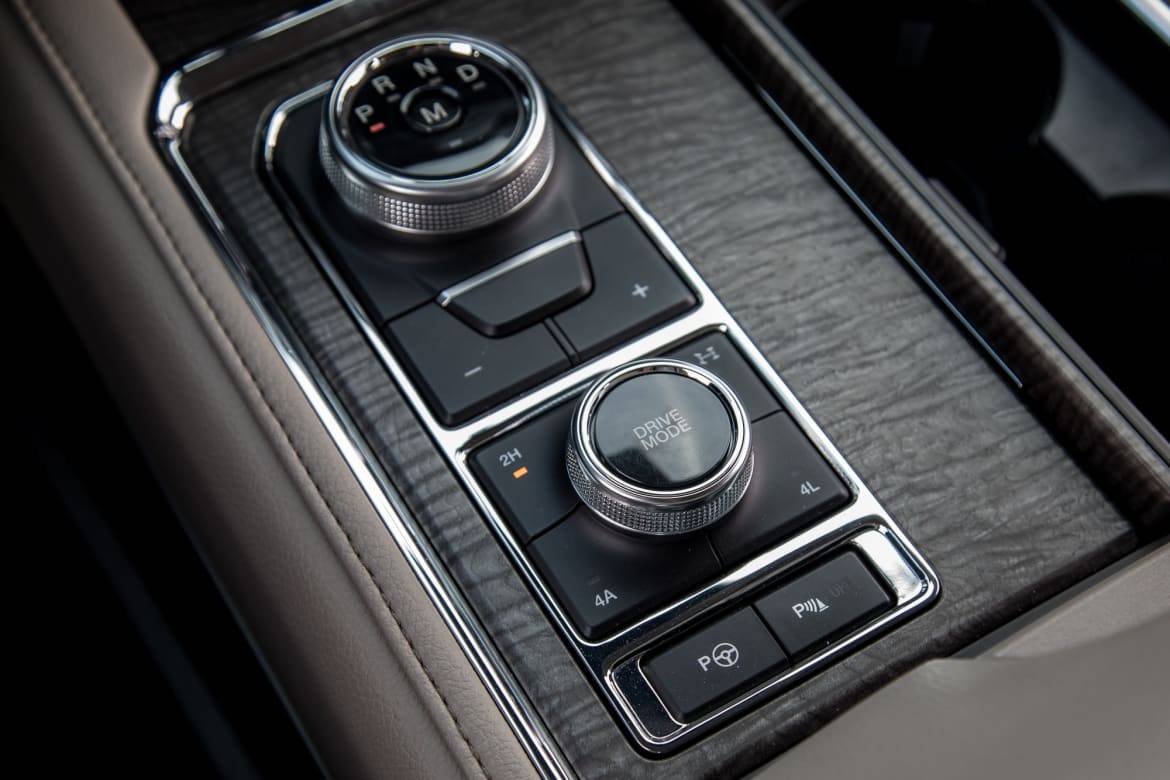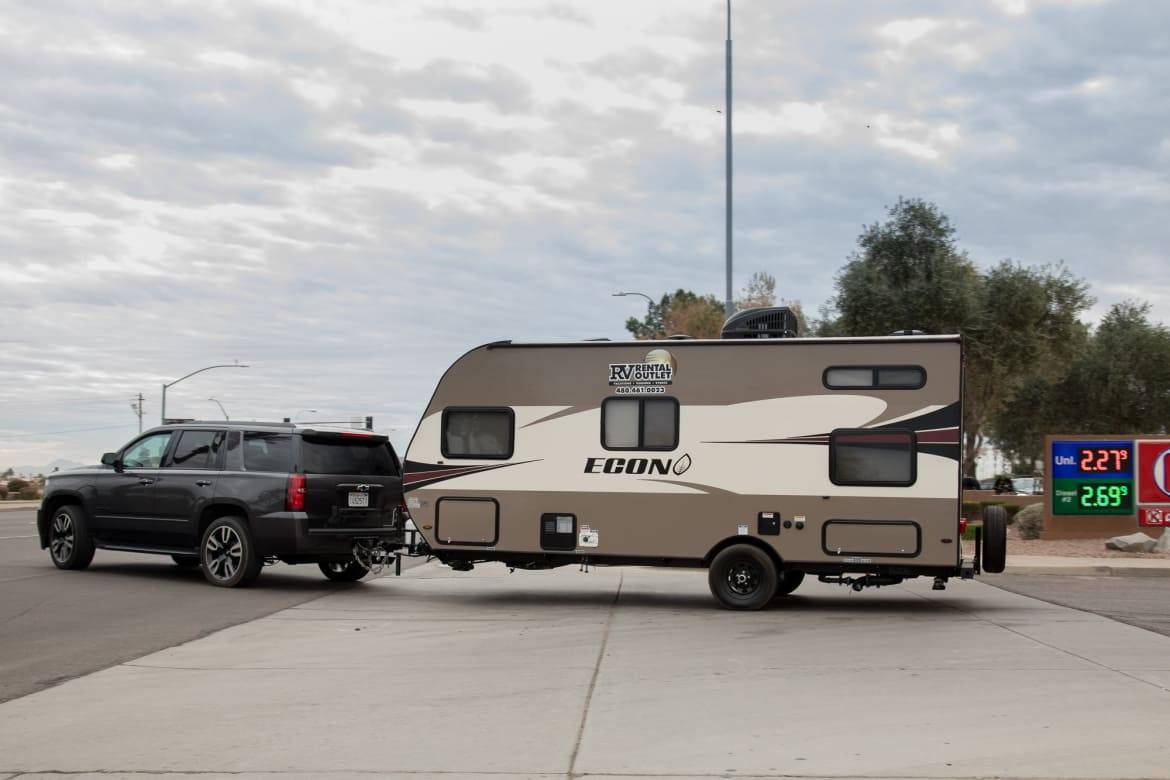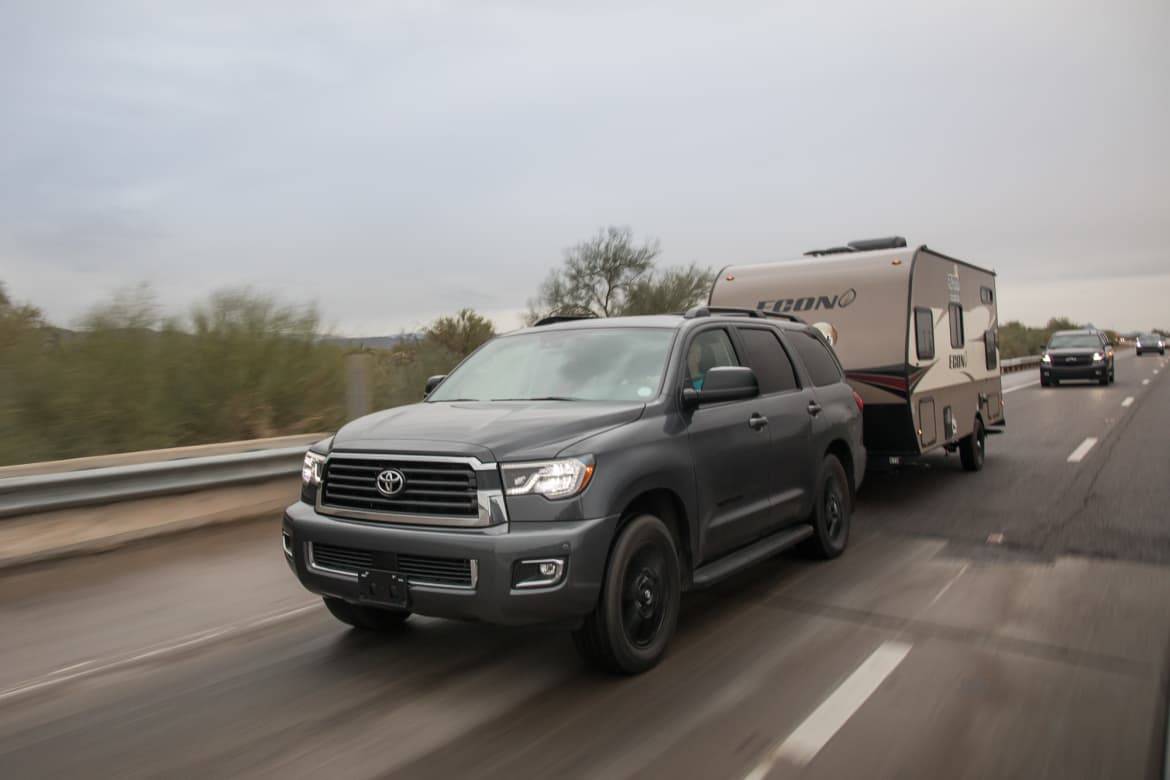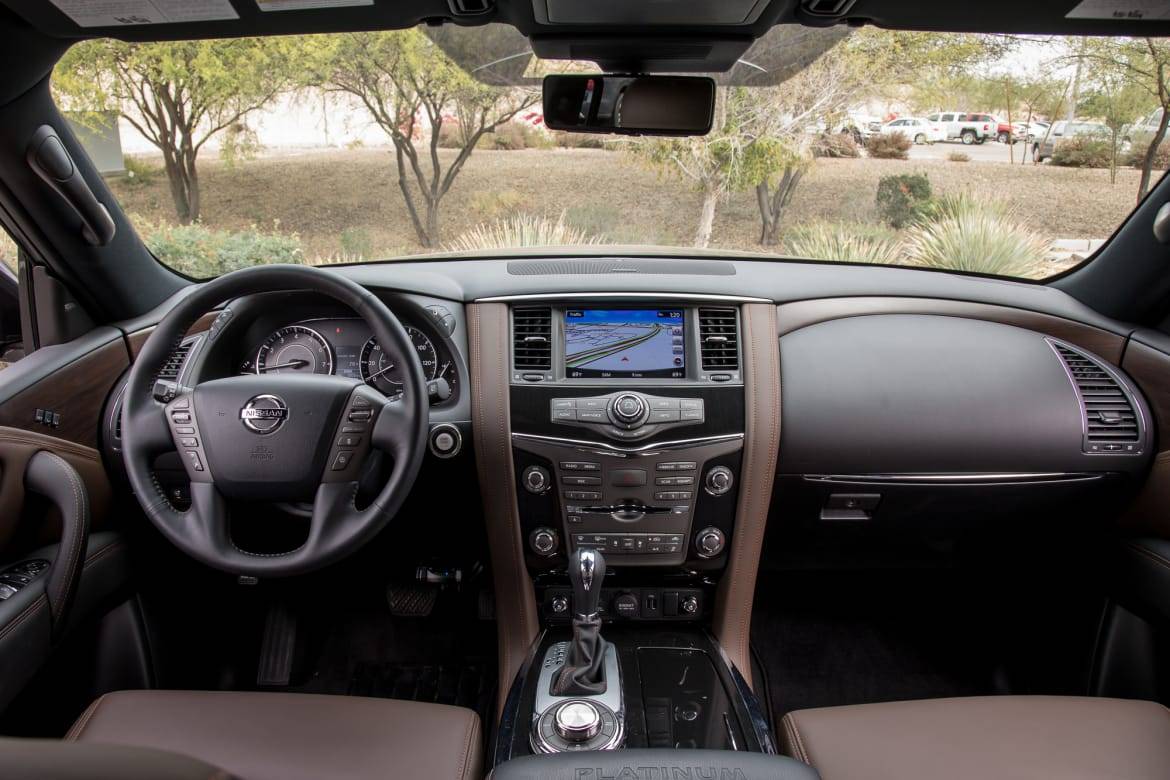Which 2018 Full-Size SUV Is the Best Tow Rig?


One reason shoppers choose a truck-based full-size SUV over a crossover or minivan is the ability to tow heavier loads while still carrying three rows of passengers and their cargo. During Cars.com’s 2018 Full-Size SUV Challenge, judges towed with the four competitors: the Chevrolet Tahoe, Ford Expedition, Nissan Armada and Toyota Sequoia. Judges Mark Williams, editor of PickupTrucks.com; Aaron Bragman, Cars.com Detroit bureau chief; and myself towed from Chandler, Ariz., through the Tonto National Forest, up twisting mountain roads to Globe, Ariz., and back. One route was completed with the trucks unloaded and the other towing a 3,500-pound camper trailer.
The 2018 Full-Size SUV Challenge
Results | Towing | Video
Drivelines and Powertrains
Three of the large SUV tow vehicles had V-8 engines, while the Ford used a twin-turbocharged 3.5-L V6 EcoBoost . While on paper it looks like the Ford is at a disadvantage with fewer cylinders and horsepower, that simply wasn’t the case with the trailer hitched to the back of the Expedition.
| SUV | Engine | Horsepower | Torque (Lbs-Feet) |
| Chevrolet Tahoe | 6.2-liter V-8 | 420 | 460 |
| Ford Expedition | Twin-turbocharged 3.5-liter V-6 | 375 | 470 |
| Nissan Armada | 5.6-liter V-8 | 390 | 394 |
| Toyota Sequoia | 5.7-liter V-8 | 381 | 401 |
The big differentiator wasn’t solely under the hood, but also in the automatic transmissions: The Sequoia had six speeds, the Armada seven, and the Tahoe and Expedition both had 10-speed transmissions developed jointly by Ford and GM.
Nothing about the Sequoia stood out when it came to towing and towing capacity. While it’s available with a towing package with a more aggressive axle ratio like the others, the TRD Sport model we tested didn’t have one. It can do the job, but not as well as the others. Adding an integrated trailer brake controller instead of the aftermarket controller we used and the higher numeric axle ratio that comes with a towing package might have helped it tow better, but that axle ratio would likely have hurt the vehicle when it came to fuel economy, where it already placed last.
Williams noted that engaging Tow/Haul mode in the Sequoia only prevented use of the 6th gear instead of the more intelligent throttle mapping and altered shift points of others in the test. He also noted that the Armada’s powertrain was working extra hard to tow, while Bragman pointed out that when the transmission kicked down to a lower gear, the Armada’s seven-speed felt “pretty violent” on steeper grades. Neither engine felt particularly strong when towing, but each felt capable if slightly unwilling, like asking a teenager to clean their room.

The 10-speeds earned special praise, with Ford getting most of it. The Expedition’s 10-speed felt nearly effortless and incredibly intelligent in its gear selection and choices to upshift, downshift or stay in gear. Bragman praised the gear display in the gauge cluster that indicates the currently selected gear, and Williams called it “by far the smartest transmission we’ve seen from just about any mainstream segment.” The brilliant transmission makes the Expedition seem like it’s got the same brute force of Chevrolet’s Tahoe.
Bragman praised the power delivery and “endless torque” of the EcoBoost V-6’s towing capacity despite its being the smallest engine of the test and having the fewest cylinders. He also noted, and the rest of the judges agreed, that it felt like the Expedition was capable of towing twice the weight with ease.
Whatever intelligence the Tahoe’s transmission lacked, it made up for with sheer towing capacity power from its massive V-8. The highest horsepower rating and second-highest torque ft-lbs rating made it always ready to jump off the line even when laden with a 3,500-pound trailer.
Fuel Economy
We measured fuel economy with an interest in the difference between no trailer and with a trailer. Surprisingly, the Tahoe came out on top in each test even with the biggest engine and most horsepower: The Tahoe averaged 22.5 mpg without a trailer and 12.1 mpg with a trailer, for a decrease of 46.2 percent. The Expedition averaged 21.6 mpg without a trailer but 10.2 mpg with a trailer, for the most significant decrease of 52.9 percent.

The EcoBoost’s drop in fuel economy is something we’ve observed in our testing of trucks equipped with other V-6 EcoBoost engines. The Armada averaged 19.8 mpg without a trailer but just made it into double digits when towing with 10 mpg, a difference of 49.8 percent. The Sequoia had the lowest disparity between without a trailer and with a trailer of 43.1 percent, but it also had the lowest fuel-economy numbers without a trailer in the test: 18.8 mpg; it got 10.7 mpg with a trailer.
Tow Hitch Receivers and Hitches
The Tahoe and Expedition’s tall bumper height required drop hitches with our rented camper trailers — where the end of the hitch drops down and puts the ball height lower than the receiver height. A taller hitch ball height can limit your trailer options or lead to unsafe towing if it places either the vehicle or trailer at an angle when attached, and the Tahoe RST required the most work to get the trailer and hitch to be friends.

The Armada and Sequoia, however, had shorter hitch heights that didn’t need a drop hitch. The Armada also offered automatic leveling of the rear suspension to compensate for trailer load to keep the headlights level and drivability as close to unloaded characteristics as possible. The Expedition and Sequoia did not have a load-leveling suspension. The Expedition didn’t significantly squat while towing, but the Sequoia certainly did. That squat didn’t lead to unsafe handling characteristics in the Toyota, fortunately, but it’s concerning that increased trailer weight could lead to more squatting and worsen the Sequoia’s handling.
Trailer Brake Controllers
The Armada was the only vehicle not available from the factory with an integrated trailer brake controller. It’s only prewired for the installation of an aftermarket controller; Nissan doesn’t offer one through dealerships as an accessory, either. All SUVs we tested did have a trailer brake controller installed, but both the Armada and Sequoia used aftermarket controllers.
In action, Bragman praised the location of the Tahoe’s factory controller, noting that it “doesn’t require me feeling around low on the dash in a time of potential crisis.”
Side Mirrors and Visibility
Some SUVs provided much better visibility than the others. Side mirrors play a significant role in towing — being able to see around the trailer and also observe trailer wheels when maneuvering. I found the Tahoe’s side mirrors to be almost comically small. That may help aerodynamics, but it doesn’t make for a great experience pulling a trailer; I guess I’m a big fan of not flattening the Mazda Miata that may be in the lane beside me. Williams thought only the Armada had mirrors that were even adequate for towing. Ordering a set of extra-wide towing mirrors isn’t the worst idea if you’re towing with any of these SUVs.
Unique Features
The Armada’s Around View Monitor proved useful when attaching the trailer, and its easily accessible Tow/Haul mode button was a great help. The auto-leveling rear suspension improves towing safety, as well.

The 6.2-liter engine is the Tahoe’s standout feature by a wide margin. Besides that, its simplicity and best-in-test fuel economy makes it a strong choice for anyone looking to tow. The column shifter with the Tow/Haul mode button on the end is perfect for towing. A head-up display also keeps the driver’s eyes on the road and away from in-cabin distractions. Small side mirrors and gigantic 22-inch wheels made the towing experience less positive, however: The larger wheels made the Tahoe easier to unsettle over bumpy roads, especially with a trailer attached, and raised the hitch height to the point that hooking up the trailer was more complicated than for the other SUVs.
Ford’s bells and whistles made up for its thirsty engine. The Expedition’s number of information screens related just to towing is incredible: It includes a safety checklist for hooking up a trailer and even offers a trailer light check system that detects when specific bulbs are out. It was also the most difficult to put into Tow/Haul mode; while the other vehicles have a dedicated button, the Expedition requires entering the car’s drive mode menu and selecting Tow/Haul among the other modes like Eco and Sport.
Pick of the Litter?
Which would we pick? In our towing scores, the Expedition averaged 8.3 out of 10 with the Tahoe averaging 7.7. The Armada came in third with 6.3, and the Sequoia brought up the rear at 5.3. Bragman and I leaned toward the Expedition, while Williams called the Tahoe his favorite — but all of us agreed that either one is a good choice if you have a trailer to tow. The Armada got the job done better than any of the judges expected, but it wasn’t as willing as the Expedition or Tahoe. We wouldn’t hesitate to use the Armada for towing, but we also wouldn’t hesitate to see if there was something better to use. As for the Sequoia, well … it sure can tow, but it wouldn’t be anyone’s first or second choice. Or third, probably.
Here’s what it takes to tow safely, courtesy of one of the judges for this Challenge, Mark Williams:
Cars.com’s Editorial department is your source for automotive news and reviews. In line with Cars.com’s long-standing ethics policy, editors and reviewers don’t accept gifts or free trips from automakers. The Editorial department is independent of Cars.com’s advertising, sales and sponsored content departments.

Road Test Editor Brian Normile joined the automotive industry and Cars.com in 2013, and he became part of the Editorial staff in 2014. Brian spent his childhood devouring every car magazine he got his hands on — not literally, eventually — and now reviews and tests vehicles to help consumers make informed choices. Someday, Brian hopes to learn what to do with his hands when he’s reviewing a car on camera. He would daily-drive an Alfa Romeo 4C if he could.
Featured stories




